THE POLITICAL AND SOCIAL MEANINGS OF KARLO ANDREI IBARRA AT CAAM
Concrete Wounds/Herida concreta is the exhibition that the Canary Islands' Centro Atlántico de Arte Moderno (CAAM) is dedicating to Karlo Andrei Ibarra (San Juan, Puerto Rico, 1982), one of the most promising and internationally renowned names of the Puerto Rican art scene. His artistic production focuses on the observation and analysis of social and political issues. For the occasion, the Puerto Rican artist has chosen to present these approaches from different techniques, thus delving into the multidisciplinary nature of the execution. Thus, objects, sculptures, installations and photographs are intermingled, translating his concepts into markedly visual languages.
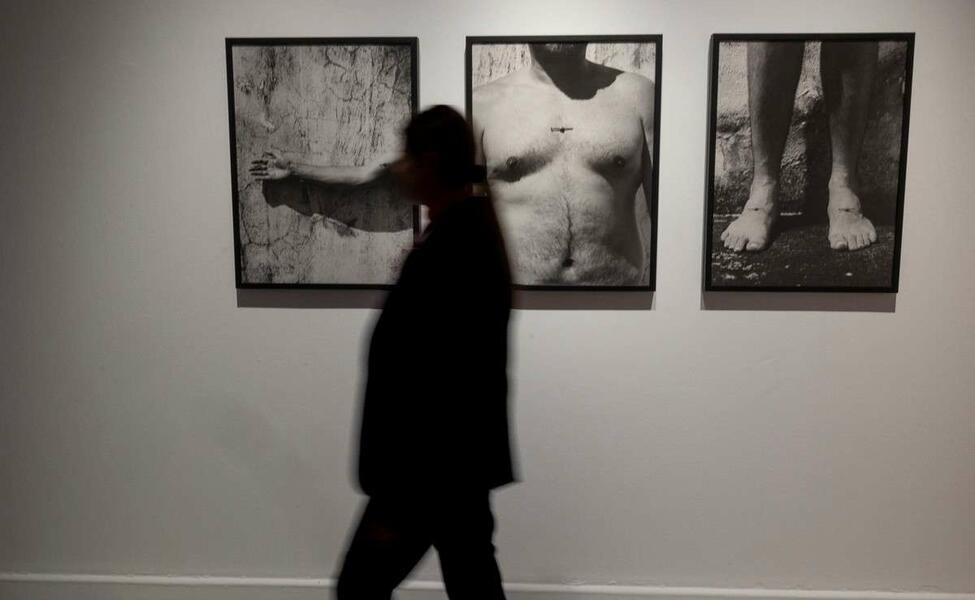
There is also a relevant circumstance in Ibarra's work and it is his observation of semantics and language and his personal experience in an environment of bilingualism and high diglossia. The title of the present exhibition also reflects this concern, and plays with the symbolism of words, specifically that English concrete word that identifies both the specific and the material and its symbolism of closing and shuttering the memory and the past and present, the same that is witness to the dramatic actions of the tourism industry and its interpretation as a new colonialist and capitalist attitude and, therefore, the object of social and economic criticism.
Concrete Wounds/Herida concreta can be seen until October 6 at CAAM- San Antonio Abad, Plaza de San Antonio Abad, s/n, Las Palmas de Gran Canaria, Spain.
Related Topics
May interest you
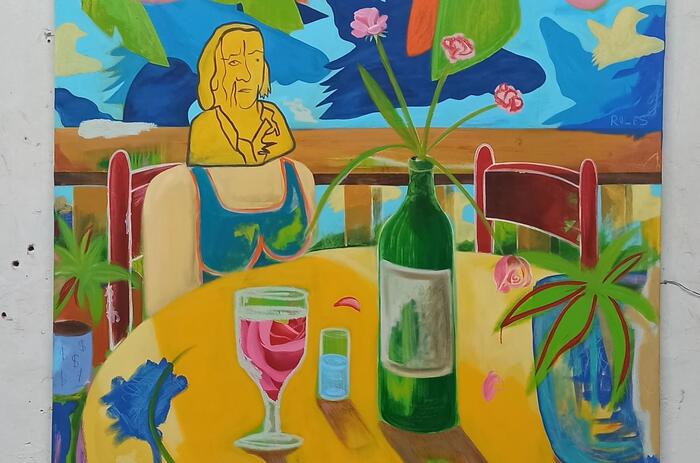
The birth of a new collective is always good news, and it is so for several reasons. Firstly, because of the existence of collective dynamics that bring together different points of view and, second, because, in a didactic way, it contributes to illustrate and understand the current cartographies of art. For the Revolú collective, formed by Andrés Meléndez (San Juan, Puerto Rico, 1996), Miguel Ángel Feba (San Juan, Puerto Rico, 1994) and Marcos Daniel Vicéns (Bayamón, Puerto Rico, 1996), their first exhibition experience is the result of an artistic residency in which, almost blindly, they have been able to build those specific ties to start from the individual and reach the group identity.
GENESIS AND BORICUA RESONANCES IN REVOLÚ
The birth of a new collective is always good news, and it is so for several reasons. Firstly, because of the existence of collective dynamics that bring together different points of view and, second, because, in a didactic way, it contributes to illustrate and understand the current cartographies of art. For the Revolú collective, formed by Andrés Meléndez (San Juan, Puerto Rico, 1996), Miguel Ángel Feba (San Juan, Puerto Rico, 1994) and Marcos Daniel Vicéns (Bayamón, Puerto Rico, 1996), their first exhibition experience is the result of an artistic residency in which, almost blindly, they have been able to build those specific ties to start from the individual and reach the group identity.

The birth of a new collective is always good news, and it is so for several reasons. Firstly, because of the existence of collective dynamics that bring together different points of view and, second, because, in a didactic way, it contributes to illustrate and understand the current cartographies of art. For the Revolú collective, formed by Andrés Meléndez (San Juan, Puerto Rico, 1996), Miguel Ángel Feba (San Juan, Puerto Rico, 1994) and Marcos Daniel Vicéns (Bayamón, Puerto Rico, 1996), their first exhibition experience is the result of an artistic residency in which, almost blindly, they have been able to build those specific ties to start from the individual and reach the group identity.
GENESIS AND BORICUA RESONANCES IN REVOLÚ
The birth of a new collective is always good news, and it is so for several reasons. Firstly, because of the existence of collective dynamics that bring together different points of view and, second, because, in a didactic way, it contributes to illustrate and understand the current cartographies of art. For the Revolú collective, formed by Andrés Meléndez (San Juan, Puerto Rico, 1996), Miguel Ángel Feba (San Juan, Puerto Rico, 1994) and Marcos Daniel Vicéns (Bayamón, Puerto Rico, 1996), their first exhibition experience is the result of an artistic residency in which, almost blindly, they have been able to build those specific ties to start from the individual and reach the group identity.
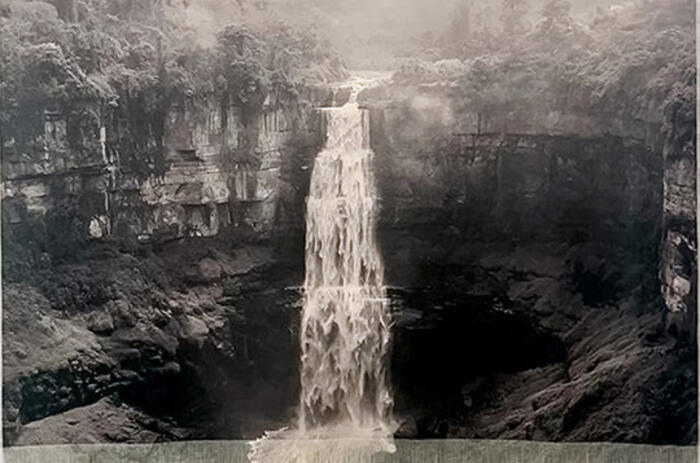
By Álvaro de Benito
The Madrid branch of La Cometa gallery presents during July the work of eight of its Ibero-American artists in a group show that delves into different languages and techniques, from ceramics to painting, and also includes dialogues with architecture and other productions. Three of those represented come from Spain, while of the five American representatives, four are Colombian and one is Cuban, which brings a representative vision of the gallery's artistic proposal closer to the spectator.
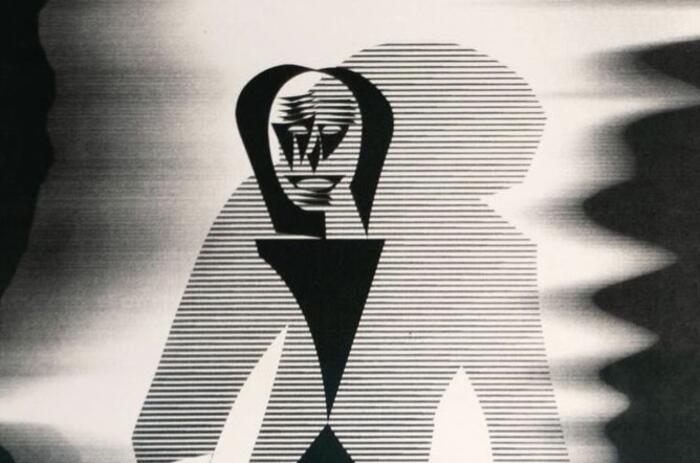
The Mexican Cultural Institute in Spain hosts the group exhibition En el interior del cielo, a show that gathers some of the most prestigious Mexican artists from the collection of Lorena Pérez-Jácome and Javier Lumbreras.
COMMUNITY AND COLLECTION AT THE CULTURAL INSTITUTE OF MEXICO
The Mexican Cultural Institute in Spain hosts the group exhibition En el interior del cielo, a show that gathers some of the most prestigious Mexican artists from the collection of Lorena Pérez-Jácome and Javier Lumbreras.
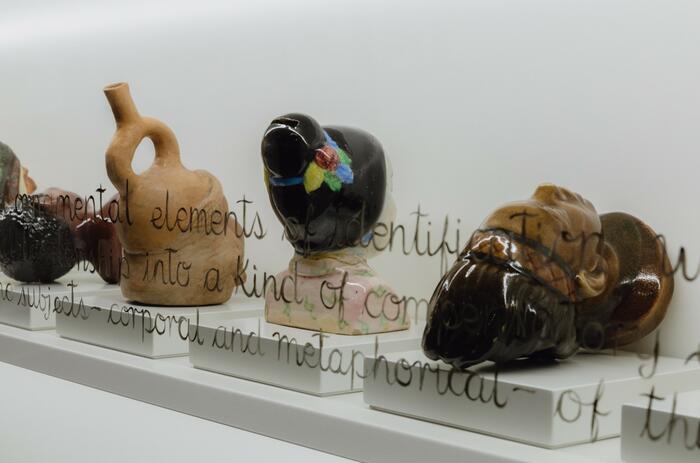
Spanish-Peruvian artist Sandra Gamarra Heshiki represents Spain at the Venice Biennale. It is the first time in 60 editions that an artist not born in Spain does so. Her project Pinacoteca migrante (Migrant gallery), questions colonial narratives and historical modes of representation.
PINACOTECA MIGRANTE: SPAIN AT THE VENICE BIENNALE
Spanish-Peruvian artist Sandra Gamarra Heshiki represents Spain at the Venice Biennale. It is the first time in 60 editions that an artist not born in Spain does so. Her project Pinacoteca migrante (Migrant gallery), questions colonial narratives and historical modes of representation.
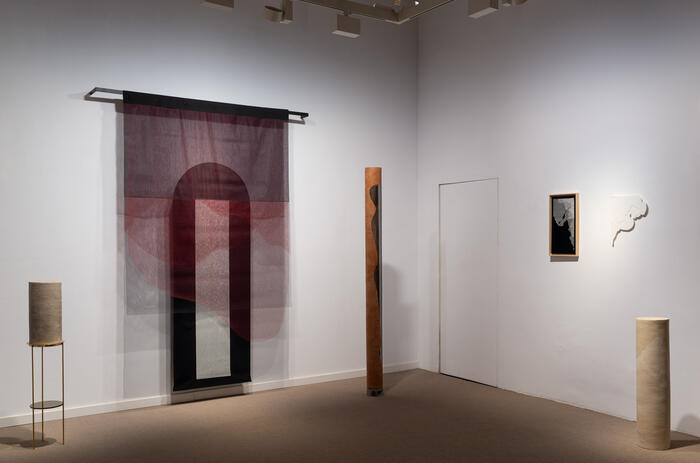
The proposal of Julia Aurora Guzmán (Santo Domingo, Dominican Republic, 1993) navigates between different techniques, addressing sculpture, textile, photography or performance and is posed as the result of the vital action itself. Her works decipher and highlight the natural cycles of life, the beginning with birth and the end with death, without forgetting the present as transience.
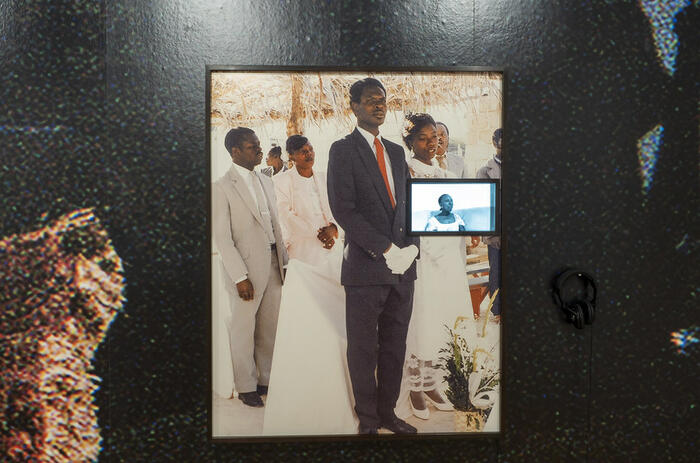
Widline Cadet (Pétion-Ville, Haiti, 1992) brings together in her life experience several of the aspects and themes that, perhaps, have inspired more production among all those curatorial lines with more presence. Her biography, constructed through childhood memories, the environment of a generation and a country marked by its own strong culture or the phenomena of emigration, constitutes the framework in which the photographer develops the practical integrity of her work.
MEMORY AND DIASPORA IN WIDLINE CADET
Widline Cadet (Pétion-Ville, Haiti, 1992) brings together in her life experience several of the aspects and themes that, perhaps, have inspired more production among all those curatorial lines with more presence. Her biography, constructed through childhood memories, the environment of a generation and a country marked by its own strong culture or the phenomena of emigration, constitutes the framework in which the photographer develops the practical integrity of her work.
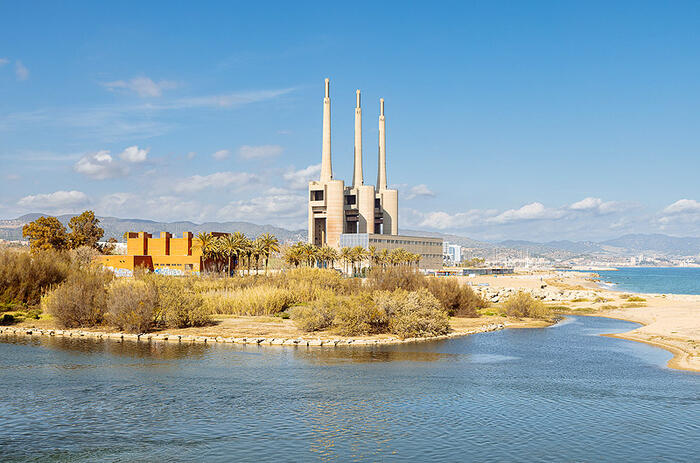
Manifesta, the European nomadic biennial, as it is defined, returns to Spain after past editions in San Sebastian (2004) and Murcia (2010) and will hold its 15th edition in the Metropolitan Area of Barcelona from September 8 to November 24. The multidisciplinary program of actions and exhibitions will be developed around the concept of place and time, focusing, through the exhibition venues chosen in the twelve participating municipalities, on the past, present and future of this region.
THE METROPOLITAN AREA OF BARCELONA HOSTS MANIFESTA 15
Manifesta, the European nomadic biennial, as it is defined, returns to Spain after past editions in San Sebastian (2004) and Murcia (2010) and will hold its 15th edition in the Metropolitan Area of Barcelona from September 8 to November 24. The multidisciplinary program of actions and exhibitions will be developed around the concept of place and time, focusing, through the exhibition venues chosen in the twelve participating municipalities, on the past, present and future of this region.
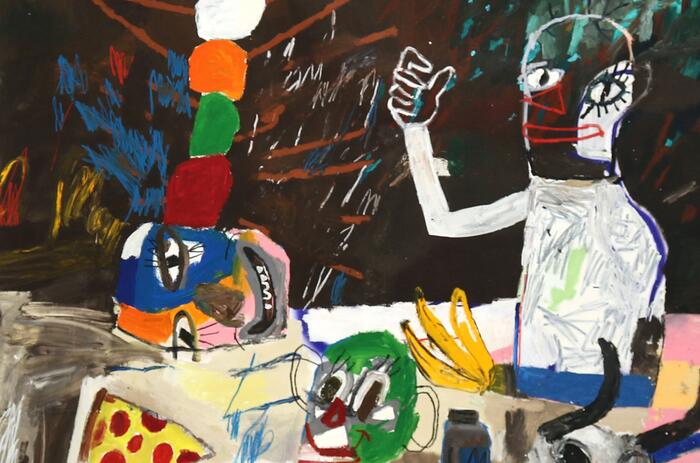
The powerful painting of Starsky Brines (Caracas, Venezuela, 1977) has in his most recent production the consolidation of one of the most intense expressions of the Latin American panorama. Collected under the accurate epigraph of Paisajes imposibles (Impossible Landscapes), the exhibition invites the spectator to let himself be impacted and submerged in a world as unreal and dreamlike as it is sometimes grotesque. These adjectives, more typical of the symptomatology of the society that underlies each of the Venezuelan's pictorial interpretations, seem to originate in the different angles that converge in Brines' universe.
HYBRID IDENTITY AND SOCIETY IN STARSKY BRINES
The powerful painting of Starsky Brines (Caracas, Venezuela, 1977) has in his most recent production the consolidation of one of the most intense expressions of the Latin American panorama. Collected under the accurate epigraph of Paisajes imposibles (Impossible Landscapes), the exhibition invites the spectator to let himself be impacted and submerged in a world as unreal and dreamlike as it is sometimes grotesque. These adjectives, more typical of the symptomatology of the society that underlies each of the Venezuelan's pictorial interpretations, seem to originate in the different angles that converge in Brines' universe.

The birth of a new collective is always good news, and it is so for several reasons. Firstly, because of the existence of collective dynamics that bring together different points of view and, second, because, in a didactic way, it contributes to illustrate and understand the current cartographies of art. For the Revolú collective, formed by Andrés Meléndez (San Juan, Puerto Rico, 1996), Miguel Ángel Feba (San Juan, Puerto Rico, 1994) and Marcos Daniel Vicéns (Bayamón, Puerto Rico, 1996), their first exhibition experience is the result of an artistic residency in which, almost blindly, they have been able to build those specific ties to start from the individual and reach the group identity.
GENESIS AND BORICUA RESONANCES IN REVOLÚ
The birth of a new collective is always good news, and it is so for several reasons. Firstly, because of the existence of collective dynamics that bring together different points of view and, second, because, in a didactic way, it contributes to illustrate and understand the current cartographies of art. For the Revolú collective, formed by Andrés Meléndez (San Juan, Puerto Rico, 1996), Miguel Ángel Feba (San Juan, Puerto Rico, 1994) and Marcos Daniel Vicéns (Bayamón, Puerto Rico, 1996), their first exhibition experience is the result of an artistic residency in which, almost blindly, they have been able to build those specific ties to start from the individual and reach the group identity.

By Álvaro de Benito
The Madrid branch of La Cometa gallery presents during July the work of eight of its Ibero-American artists in a group show that delves into different languages and techniques, from ceramics to painting, and also includes dialogues with architecture and other productions. Three of those represented come from Spain, while of the five American representatives, four are Colombian and one is Cuban, which brings a representative vision of the gallery's artistic proposal closer to the spectator.

The Mexican Cultural Institute in Spain hosts the group exhibition En el interior del cielo, a show that gathers some of the most prestigious Mexican artists from the collection of Lorena Pérez-Jácome and Javier Lumbreras.
COMMUNITY AND COLLECTION AT THE CULTURAL INSTITUTE OF MEXICO
The Mexican Cultural Institute in Spain hosts the group exhibition En el interior del cielo, a show that gathers some of the most prestigious Mexican artists from the collection of Lorena Pérez-Jácome and Javier Lumbreras.

Spanish-Peruvian artist Sandra Gamarra Heshiki represents Spain at the Venice Biennale. It is the first time in 60 editions that an artist not born in Spain does so. Her project Pinacoteca migrante (Migrant gallery), questions colonial narratives and historical modes of representation.
PINACOTECA MIGRANTE: SPAIN AT THE VENICE BIENNALE
Spanish-Peruvian artist Sandra Gamarra Heshiki represents Spain at the Venice Biennale. It is the first time in 60 editions that an artist not born in Spain does so. Her project Pinacoteca migrante (Migrant gallery), questions colonial narratives and historical modes of representation.

The proposal of Julia Aurora Guzmán (Santo Domingo, Dominican Republic, 1993) navigates between different techniques, addressing sculpture, textile, photography or performance and is posed as the result of the vital action itself. Her works decipher and highlight the natural cycles of life, the beginning with birth and the end with death, without forgetting the present as transience.

Widline Cadet (Pétion-Ville, Haiti, 1992) brings together in her life experience several of the aspects and themes that, perhaps, have inspired more production among all those curatorial lines with more presence. Her biography, constructed through childhood memories, the environment of a generation and a country marked by its own strong culture or the phenomena of emigration, constitutes the framework in which the photographer develops the practical integrity of her work.
MEMORY AND DIASPORA IN WIDLINE CADET
Widline Cadet (Pétion-Ville, Haiti, 1992) brings together in her life experience several of the aspects and themes that, perhaps, have inspired more production among all those curatorial lines with more presence. Her biography, constructed through childhood memories, the environment of a generation and a country marked by its own strong culture or the phenomena of emigration, constitutes the framework in which the photographer develops the practical integrity of her work.

Manifesta, the European nomadic biennial, as it is defined, returns to Spain after past editions in San Sebastian (2004) and Murcia (2010) and will hold its 15th edition in the Metropolitan Area of Barcelona from September 8 to November 24. The multidisciplinary program of actions and exhibitions will be developed around the concept of place and time, focusing, through the exhibition venues chosen in the twelve participating municipalities, on the past, present and future of this region.
THE METROPOLITAN AREA OF BARCELONA HOSTS MANIFESTA 15
Manifesta, the European nomadic biennial, as it is defined, returns to Spain after past editions in San Sebastian (2004) and Murcia (2010) and will hold its 15th edition in the Metropolitan Area of Barcelona from September 8 to November 24. The multidisciplinary program of actions and exhibitions will be developed around the concept of place and time, focusing, through the exhibition venues chosen in the twelve participating municipalities, on the past, present and future of this region.

The powerful painting of Starsky Brines (Caracas, Venezuela, 1977) has in his most recent production the consolidation of one of the most intense expressions of the Latin American panorama. Collected under the accurate epigraph of Paisajes imposibles (Impossible Landscapes), the exhibition invites the spectator to let himself be impacted and submerged in a world as unreal and dreamlike as it is sometimes grotesque. These adjectives, more typical of the symptomatology of the society that underlies each of the Venezuelan's pictorial interpretations, seem to originate in the different angles that converge in Brines' universe.
HYBRID IDENTITY AND SOCIETY IN STARSKY BRINES
The powerful painting of Starsky Brines (Caracas, Venezuela, 1977) has in his most recent production the consolidation of one of the most intense expressions of the Latin American panorama. Collected under the accurate epigraph of Paisajes imposibles (Impossible Landscapes), the exhibition invites the spectator to let himself be impacted and submerged in a world as unreal and dreamlike as it is sometimes grotesque. These adjectives, more typical of the symptomatology of the society that underlies each of the Venezuelan's pictorial interpretations, seem to originate in the different angles that converge in Brines' universe.

The birth of a new collective is always good news, and it is so for several reasons. Firstly, because of the existence of collective dynamics that bring together different points of view and, second, because, in a didactic way, it contributes to illustrate and understand the current cartographies of art. For the Revolú collective, formed by Andrés Meléndez (San Juan, Puerto Rico, 1996), Miguel Ángel Feba (San Juan, Puerto Rico, 1994) and Marcos Daniel Vicéns (Bayamón, Puerto Rico, 1996), their first exhibition experience is the result of an artistic residency in which, almost blindly, they have been able to build those specific ties to start from the individual and reach the group identity.
GENESIS AND BORICUA RESONANCES IN REVOLÚ
The birth of a new collective is always good news, and it is so for several reasons. Firstly, because of the existence of collective dynamics that bring together different points of view and, second, because, in a didactic way, it contributes to illustrate and understand the current cartographies of art. For the Revolú collective, formed by Andrés Meléndez (San Juan, Puerto Rico, 1996), Miguel Ángel Feba (San Juan, Puerto Rico, 1994) and Marcos Daniel Vicéns (Bayamón, Puerto Rico, 1996), their first exhibition experience is the result of an artistic residency in which, almost blindly, they have been able to build those specific ties to start from the individual and reach the group identity.

By Álvaro de Benito
The Madrid branch of La Cometa gallery presents during July the work of eight of its Ibero-American artists in a group show that delves into different languages and techniques, from ceramics to painting, and also includes dialogues with architecture and other productions. Three of those represented come from Spain, while of the five American representatives, four are Colombian and one is Cuban, which brings a representative vision of the gallery's artistic proposal closer to the spectator.

The Mexican Cultural Institute in Spain hosts the group exhibition En el interior del cielo, a show that gathers some of the most prestigious Mexican artists from the collection of Lorena Pérez-Jácome and Javier Lumbreras.
COMMUNITY AND COLLECTION AT THE CULTURAL INSTITUTE OF MEXICO
The Mexican Cultural Institute in Spain hosts the group exhibition En el interior del cielo, a show that gathers some of the most prestigious Mexican artists from the collection of Lorena Pérez-Jácome and Javier Lumbreras.

Spanish-Peruvian artist Sandra Gamarra Heshiki represents Spain at the Venice Biennale. It is the first time in 60 editions that an artist not born in Spain does so. Her project Pinacoteca migrante (Migrant gallery), questions colonial narratives and historical modes of representation.
PINACOTECA MIGRANTE: SPAIN AT THE VENICE BIENNALE
Spanish-Peruvian artist Sandra Gamarra Heshiki represents Spain at the Venice Biennale. It is the first time in 60 editions that an artist not born in Spain does so. Her project Pinacoteca migrante (Migrant gallery), questions colonial narratives and historical modes of representation.

The proposal of Julia Aurora Guzmán (Santo Domingo, Dominican Republic, 1993) navigates between different techniques, addressing sculpture, textile, photography or performance and is posed as the result of the vital action itself. Her works decipher and highlight the natural cycles of life, the beginning with birth and the end with death, without forgetting the present as transience.

Widline Cadet (Pétion-Ville, Haiti, 1992) brings together in her life experience several of the aspects and themes that, perhaps, have inspired more production among all those curatorial lines with more presence. Her biography, constructed through childhood memories, the environment of a generation and a country marked by its own strong culture or the phenomena of emigration, constitutes the framework in which the photographer develops the practical integrity of her work.
MEMORY AND DIASPORA IN WIDLINE CADET
Widline Cadet (Pétion-Ville, Haiti, 1992) brings together in her life experience several of the aspects and themes that, perhaps, have inspired more production among all those curatorial lines with more presence. Her biography, constructed through childhood memories, the environment of a generation and a country marked by its own strong culture or the phenomena of emigration, constitutes the framework in which the photographer develops the practical integrity of her work.

Manifesta, the European nomadic biennial, as it is defined, returns to Spain after past editions in San Sebastian (2004) and Murcia (2010) and will hold its 15th edition in the Metropolitan Area of Barcelona from September 8 to November 24. The multidisciplinary program of actions and exhibitions will be developed around the concept of place and time, focusing, through the exhibition venues chosen in the twelve participating municipalities, on the past, present and future of this region.
THE METROPOLITAN AREA OF BARCELONA HOSTS MANIFESTA 15
Manifesta, the European nomadic biennial, as it is defined, returns to Spain after past editions in San Sebastian (2004) and Murcia (2010) and will hold its 15th edition in the Metropolitan Area of Barcelona from September 8 to November 24. The multidisciplinary program of actions and exhibitions will be developed around the concept of place and time, focusing, through the exhibition venues chosen in the twelve participating municipalities, on the past, present and future of this region.

The powerful painting of Starsky Brines (Caracas, Venezuela, 1977) has in his most recent production the consolidation of one of the most intense expressions of the Latin American panorama. Collected under the accurate epigraph of Paisajes imposibles (Impossible Landscapes), the exhibition invites the spectator to let himself be impacted and submerged in a world as unreal and dreamlike as it is sometimes grotesque. These adjectives, more typical of the symptomatology of the society that underlies each of the Venezuelan's pictorial interpretations, seem to originate in the different angles that converge in Brines' universe.
HYBRID IDENTITY AND SOCIETY IN STARSKY BRINES
The powerful painting of Starsky Brines (Caracas, Venezuela, 1977) has in his most recent production the consolidation of one of the most intense expressions of the Latin American panorama. Collected under the accurate epigraph of Paisajes imposibles (Impossible Landscapes), the exhibition invites the spectator to let himself be impacted and submerged in a world as unreal and dreamlike as it is sometimes grotesque. These adjectives, more typical of the symptomatology of the society that underlies each of the Venezuelan's pictorial interpretations, seem to originate in the different angles that converge in Brines' universe.

The birth of a new collective is always good news, and it is so for several reasons. Firstly, because of the existence of collective dynamics that bring together different points of view and, second, because, in a didactic way, it contributes to illustrate and understand the current cartographies of art. For the Revolú collective, formed by Andrés Meléndez (San Juan, Puerto Rico, 1996), Miguel Ángel Feba (San Juan, Puerto Rico, 1994) and Marcos Daniel Vicéns (Bayamón, Puerto Rico, 1996), their first exhibition experience is the result of an artistic residency in which, almost blindly, they have been able to build those specific ties to start from the individual and reach the group identity.
GENESIS AND BORICUA RESONANCES IN REVOLÚ
The birth of a new collective is always good news, and it is so for several reasons. Firstly, because of the existence of collective dynamics that bring together different points of view and, second, because, in a didactic way, it contributes to illustrate and understand the current cartographies of art. For the Revolú collective, formed by Andrés Meléndez (San Juan, Puerto Rico, 1996), Miguel Ángel Feba (San Juan, Puerto Rico, 1994) and Marcos Daniel Vicéns (Bayamón, Puerto Rico, 1996), their first exhibition experience is the result of an artistic residency in which, almost blindly, they have been able to build those specific ties to start from the individual and reach the group identity.

By Álvaro de Benito
The Madrid branch of La Cometa gallery presents during July the work of eight of its Ibero-American artists in a group show that delves into different languages and techniques, from ceramics to painting, and also includes dialogues with architecture and other productions. Three of those represented come from Spain, while of the five American representatives, four are Colombian and one is Cuban, which brings a representative vision of the gallery's artistic proposal closer to the spectator.

The Mexican Cultural Institute in Spain hosts the group exhibition En el interior del cielo, a show that gathers some of the most prestigious Mexican artists from the collection of Lorena Pérez-Jácome and Javier Lumbreras.
COMMUNITY AND COLLECTION AT THE CULTURAL INSTITUTE OF MEXICO
The Mexican Cultural Institute in Spain hosts the group exhibition En el interior del cielo, a show that gathers some of the most prestigious Mexican artists from the collection of Lorena Pérez-Jácome and Javier Lumbreras.

Spanish-Peruvian artist Sandra Gamarra Heshiki represents Spain at the Venice Biennale. It is the first time in 60 editions that an artist not born in Spain does so. Her project Pinacoteca migrante (Migrant gallery), questions colonial narratives and historical modes of representation.
PINACOTECA MIGRANTE: SPAIN AT THE VENICE BIENNALE
Spanish-Peruvian artist Sandra Gamarra Heshiki represents Spain at the Venice Biennale. It is the first time in 60 editions that an artist not born in Spain does so. Her project Pinacoteca migrante (Migrant gallery), questions colonial narratives and historical modes of representation.

The proposal of Julia Aurora Guzmán (Santo Domingo, Dominican Republic, 1993) navigates between different techniques, addressing sculpture, textile, photography or performance and is posed as the result of the vital action itself. Her works decipher and highlight the natural cycles of life, the beginning with birth and the end with death, without forgetting the present as transience.

Widline Cadet (Pétion-Ville, Haiti, 1992) brings together in her life experience several of the aspects and themes that, perhaps, have inspired more production among all those curatorial lines with more presence. Her biography, constructed through childhood memories, the environment of a generation and a country marked by its own strong culture or the phenomena of emigration, constitutes the framework in which the photographer develops the practical integrity of her work.
MEMORY AND DIASPORA IN WIDLINE CADET
Widline Cadet (Pétion-Ville, Haiti, 1992) brings together in her life experience several of the aspects and themes that, perhaps, have inspired more production among all those curatorial lines with more presence. Her biography, constructed through childhood memories, the environment of a generation and a country marked by its own strong culture or the phenomena of emigration, constitutes the framework in which the photographer develops the practical integrity of her work.

Manifesta, the European nomadic biennial, as it is defined, returns to Spain after past editions in San Sebastian (2004) and Murcia (2010) and will hold its 15th edition in the Metropolitan Area of Barcelona from September 8 to November 24. The multidisciplinary program of actions and exhibitions will be developed around the concept of place and time, focusing, through the exhibition venues chosen in the twelve participating municipalities, on the past, present and future of this region.
THE METROPOLITAN AREA OF BARCELONA HOSTS MANIFESTA 15
Manifesta, the European nomadic biennial, as it is defined, returns to Spain after past editions in San Sebastian (2004) and Murcia (2010) and will hold its 15th edition in the Metropolitan Area of Barcelona from September 8 to November 24. The multidisciplinary program of actions and exhibitions will be developed around the concept of place and time, focusing, through the exhibition venues chosen in the twelve participating municipalities, on the past, present and future of this region.

The powerful painting of Starsky Brines (Caracas, Venezuela, 1977) has in his most recent production the consolidation of one of the most intense expressions of the Latin American panorama. Collected under the accurate epigraph of Paisajes imposibles (Impossible Landscapes), the exhibition invites the spectator to let himself be impacted and submerged in a world as unreal and dreamlike as it is sometimes grotesque. These adjectives, more typical of the symptomatology of the society that underlies each of the Venezuelan's pictorial interpretations, seem to originate in the different angles that converge in Brines' universe.
HYBRID IDENTITY AND SOCIETY IN STARSKY BRINES
The powerful painting of Starsky Brines (Caracas, Venezuela, 1977) has in his most recent production the consolidation of one of the most intense expressions of the Latin American panorama. Collected under the accurate epigraph of Paisajes imposibles (Impossible Landscapes), the exhibition invites the spectator to let himself be impacted and submerged in a world as unreal and dreamlike as it is sometimes grotesque. These adjectives, more typical of the symptomatology of the society that underlies each of the Venezuelan's pictorial interpretations, seem to originate in the different angles that converge in Brines' universe.

The birth of a new collective is always good news, and it is so for several reasons. Firstly, because of the existence of collective dynamics that bring together different points of view and, second, because, in a didactic way, it contributes to illustrate and understand the current cartographies of art. For the Revolú collective, formed by Andrés Meléndez (San Juan, Puerto Rico, 1996), Miguel Ángel Feba (San Juan, Puerto Rico, 1994) and Marcos Daniel Vicéns (Bayamón, Puerto Rico, 1996), their first exhibition experience is the result of an artistic residency in which, almost blindly, they have been able to build those specific ties to start from the individual and reach the group identity.
GENESIS AND BORICUA RESONANCES IN REVOLÚ
The birth of a new collective is always good news, and it is so for several reasons. Firstly, because of the existence of collective dynamics that bring together different points of view and, second, because, in a didactic way, it contributes to illustrate and understand the current cartographies of art. For the Revolú collective, formed by Andrés Meléndez (San Juan, Puerto Rico, 1996), Miguel Ángel Feba (San Juan, Puerto Rico, 1994) and Marcos Daniel Vicéns (Bayamón, Puerto Rico, 1996), their first exhibition experience is the result of an artistic residency in which, almost blindly, they have been able to build those specific ties to start from the individual and reach the group identity.

By Álvaro de Benito
The Madrid branch of La Cometa gallery presents during July the work of eight of its Ibero-American artists in a group show that delves into different languages and techniques, from ceramics to painting, and also includes dialogues with architecture and other productions. Three of those represented come from Spain, while of the five American representatives, four are Colombian and one is Cuban, which brings a representative vision of the gallery's artistic proposal closer to the spectator.

The Mexican Cultural Institute in Spain hosts the group exhibition En el interior del cielo, a show that gathers some of the most prestigious Mexican artists from the collection of Lorena Pérez-Jácome and Javier Lumbreras.
COMMUNITY AND COLLECTION AT THE CULTURAL INSTITUTE OF MEXICO
The Mexican Cultural Institute in Spain hosts the group exhibition En el interior del cielo, a show that gathers some of the most prestigious Mexican artists from the collection of Lorena Pérez-Jácome and Javier Lumbreras.

Spanish-Peruvian artist Sandra Gamarra Heshiki represents Spain at the Venice Biennale. It is the first time in 60 editions that an artist not born in Spain does so. Her project Pinacoteca migrante (Migrant gallery), questions colonial narratives and historical modes of representation.
PINACOTECA MIGRANTE: SPAIN AT THE VENICE BIENNALE
Spanish-Peruvian artist Sandra Gamarra Heshiki represents Spain at the Venice Biennale. It is the first time in 60 editions that an artist not born in Spain does so. Her project Pinacoteca migrante (Migrant gallery), questions colonial narratives and historical modes of representation.

The proposal of Julia Aurora Guzmán (Santo Domingo, Dominican Republic, 1993) navigates between different techniques, addressing sculpture, textile, photography or performance and is posed as the result of the vital action itself. Her works decipher and highlight the natural cycles of life, the beginning with birth and the end with death, without forgetting the present as transience.

Widline Cadet (Pétion-Ville, Haiti, 1992) brings together in her life experience several of the aspects and themes that, perhaps, have inspired more production among all those curatorial lines with more presence. Her biography, constructed through childhood memories, the environment of a generation and a country marked by its own strong culture or the phenomena of emigration, constitutes the framework in which the photographer develops the practical integrity of her work.
MEMORY AND DIASPORA IN WIDLINE CADET
Widline Cadet (Pétion-Ville, Haiti, 1992) brings together in her life experience several of the aspects and themes that, perhaps, have inspired more production among all those curatorial lines with more presence. Her biography, constructed through childhood memories, the environment of a generation and a country marked by its own strong culture or the phenomena of emigration, constitutes the framework in which the photographer develops the practical integrity of her work.

Manifesta, the European nomadic biennial, as it is defined, returns to Spain after past editions in San Sebastian (2004) and Murcia (2010) and will hold its 15th edition in the Metropolitan Area of Barcelona from September 8 to November 24. The multidisciplinary program of actions and exhibitions will be developed around the concept of place and time, focusing, through the exhibition venues chosen in the twelve participating municipalities, on the past, present and future of this region.
THE METROPOLITAN AREA OF BARCELONA HOSTS MANIFESTA 15
Manifesta, the European nomadic biennial, as it is defined, returns to Spain after past editions in San Sebastian (2004) and Murcia (2010) and will hold its 15th edition in the Metropolitan Area of Barcelona from September 8 to November 24. The multidisciplinary program of actions and exhibitions will be developed around the concept of place and time, focusing, through the exhibition venues chosen in the twelve participating municipalities, on the past, present and future of this region.

The powerful painting of Starsky Brines (Caracas, Venezuela, 1977) has in his most recent production the consolidation of one of the most intense expressions of the Latin American panorama. Collected under the accurate epigraph of Paisajes imposibles (Impossible Landscapes), the exhibition invites the spectator to let himself be impacted and submerged in a world as unreal and dreamlike as it is sometimes grotesque. These adjectives, more typical of the symptomatology of the society that underlies each of the Venezuelan's pictorial interpretations, seem to originate in the different angles that converge in Brines' universe.
HYBRID IDENTITY AND SOCIETY IN STARSKY BRINES
The powerful painting of Starsky Brines (Caracas, Venezuela, 1977) has in his most recent production the consolidation of one of the most intense expressions of the Latin American panorama. Collected under the accurate epigraph of Paisajes imposibles (Impossible Landscapes), the exhibition invites the spectator to let himself be impacted and submerged in a world as unreal and dreamlike as it is sometimes grotesque. These adjectives, more typical of the symptomatology of the society that underlies each of the Venezuelan's pictorial interpretations, seem to originate in the different angles that converge in Brines' universe.




